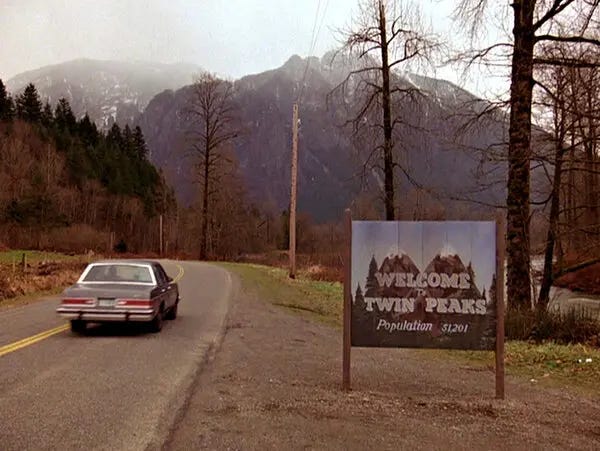David Lynch left us with a singular creative legacy—an ability to turn the familiar inside out, revealing a world teeming with beauty and unease. His work was a genre-bending blend: surrealism with small-town Americana, abstraction with vivid figuration, ethereal dream worlds with industrial grit. It juxtaposed chaos with extraordinary focus, inviting us to embrace the unknown.
As music makers, we can learn a lot from Lynch about the creative process. His work reminds us that the most artistically distinctive creations often emerge from synthesizing disparate ideas and trusting our strangest instincts. This letter is a celebration of Lynch’s approach—a tribute to his fearless pursuit of the weird, the beautiful, and the profound
The North West
I first went deep on David Lynch during the summer of 2011, when I was living in Seward, Alaska. I had just finished my first year in New York City after college and needed time away to reset. I stayed with my sister and her newborn, working at an underwater fantasy-themed coffee shop. In the mornings, I’d go for runs along Resurrection Bay, the jagged peaks of the fjords towering across the water. In the afternoons, I’d sit with my guitar, writing songs and working through Julia Cameron’s The Artist’s Way.
It was during this time that I discovered Twin Peaks. I watched the entire series, devoured everything I could read about it, and sought out the rest of Lynch’s narrative universe. got to know the music of Julee Cruise and Angelo Badalamenti, trying to trace the emotional threads that tied it all together. “how,” I wondered, “does he come up with this shit?”
Seward itself felt strangely Lynchian—a town suspended between its otherworldly natural beauty and the quiet banality of small-town life. The endless summer dusk and eerie stillness of the fjords felt like a mirror to the contrasts I saw in Twin Peaks: the beautiful and the sinister, the intimate and the unknowable.
Immersed in the contrasts of Alaska, I found echoes of Lynch’s ability to capture beauty and unease in equal measure. Twin Peaks became a lens for interpreting my surroundings and a guide for navigating my own creative development. His ability to hold opposites in tension—to find meaning in the interplay of the surreal and the ordinary—holds a certain kind of experiential weight for me.
"Intuition is the key to everything, in painting, filmmaking, business—everything. I think you could have an intellectual ability, but if you can sharpen your intuition, which they say is emotion and intellect joining together, then a knowingness occurs."
Strange and Familiar
Lynch’s work shows us the magic of synthesis: taking ideas or elements that seem unrelated and combining them to create something deeply original. He once described this process as a kind of magnetism, where ideas naturally find each other when the conditions are right.
Take Twin Peaks as an example. Lynch combined the pastoral warmth of a small town, the melodrama of soap operas, and the eerie surrealism of the dream world. On their own, these elements might seem incompatible, but Lynch trusted his instincts, creating a tension that feels both familiar and alien.
Lynch didn’t overthink how ideas fit together; he trusted the process, letting the connections emerge organically. This is the valuable lesson for creative producers: don’t discard an idea just because it feels "out of place." Instead, sit with it. Let it live alongside your other inspirations. Sometimes, it’s the friction between opposites that generates the spark. The ideas will find each other in ways you can’t predict or control.
The Subconscious
“If you want to catch little fish, you can stay in the shallow water. But if you want to catch the big fish, you’ve got to go deeper.”
This is how David Lynch described the process of gathering ideas, likening them to fish swimming in the depths of the subconscious. For Lynch, accessing those depths was a creative superpower, one he cultivated daily through meditation. He credited this practice with clearing his mind, creating space for his most profound ideas to emerge—not as forced constructions but as discoveries.
Lynch’s process was deeply intuitive. He trusted the magnetism of ideas, allowing them to connect and reveal their relationships naturally. This approach enabled him to explore contradictions—juxtaposing the mundane and the surreal, the beautiful and the grotesque—to create works that defied easy categorization. As he once said, “There’s goodness in the world, and there’s darkness in the world. They live side by side. I like to play with both.” By diving into his subconscious, Lynch found a rich reservoir of imagery, emotions, and abstractions that could not be fully expressed with words alone. His willingness to embrace the unknown—to follow a thread without overanalyzing it—is a reminder that the creative process is as much about trust as it is about craft.
Collaboration
When Lynch and Mark Frost created Twin Peaks, it really was groundbreaking network television. The show combined his Lynch’s surrealist vision with Frost’s narrative focus to make something that resonant on many levels.
Frost’s more narrative approach to storytelling complemented Lynch’s love for abstraction, grounding the surreal in a compelling story, like Laura Palmer’s tragic arc amidst the supernatural chaos. This partnership, though personally fraught shows us something essential about the creative process: collaboration doesn’t dilute your vision; it strengthens it. Those familiar with the show will be familiar with a certain period in Season 2 when Mark Frost left the show, and things get really, really weird.
Lynch was also an active collaborator on his musical scores. His partnership with Angelo Badalamenti yielded one of the most haunting and iconic scores in television history. He sat with Badalamenti and walked him through the emotional arc of Laura Palmer’s theme. Badalamenti brought Lynch’s emotional tone to life, translating surreal imagery into sound.
Things we can Learn from Lynch
1. Blend Disparate Influences Lynch’s work thrives on contrasts. For music makers, this could mean combining genres that seem at odds—pairing the rawness of field recordings with polished electronic textures, or layering dissonant harmonies over a bright, major-key progression. Trust the tension. The interplay between opposites often creates something deeply resonant.
2. Tap Into Your Subconscious Lynch’s process revolved around accessing the subconscious, whether through meditation or dream imagery. For musicians, this might involve keeping a dream diary or improvising freely without judgment. The key is to create an environment where ideas flow without inhibition—whether that’s through journaling, looping sessions in your DAW, or exploring sounds without a fixed goal.
3. Trust the Process Creativity isn’t always tidy. Lynch didn’t start with a clear plan; he let his ideas evolve. Similarly, don’t be afraid to work without a roadmap. Begin with fragments—a melody, a rhythm, a texture—and let them guide you. Sometimes, the best discoveries happen when you relinquish control.
4. Embrace the Strange Lynch leaned into his weirdest ideas, even when they defied logic. This is a call for music makers to trust their unconventional instincts. Whether it’s an odd time signature, an unsettling sound design, or an unusual arrangement, let the "weird" elements shine—they’re often the ones that make your work unforgettable.
5. Collaborate Lynch’s partnerships remind us that collaboration is a creative superpower. Bring in others who can challenge you, expand your vision, or fill in gaps in your skills. A fresh perspective can transform your work in ways you never expected.
Living Mystery
David Lynch’s work reminds us that art is a multidimensional exploration—at times quite simple, and at others, incomprehensibly complex. We dive deep into our subconscious, synthesizing influences, and embracing the beauty of contradictions, collaborating with others, trusting that eventually, we will get to something gorgeous. His legacy challenges every creator to dive into the unknown, push boundaries, and let their weirdest ideas take flight.
Thank you.





